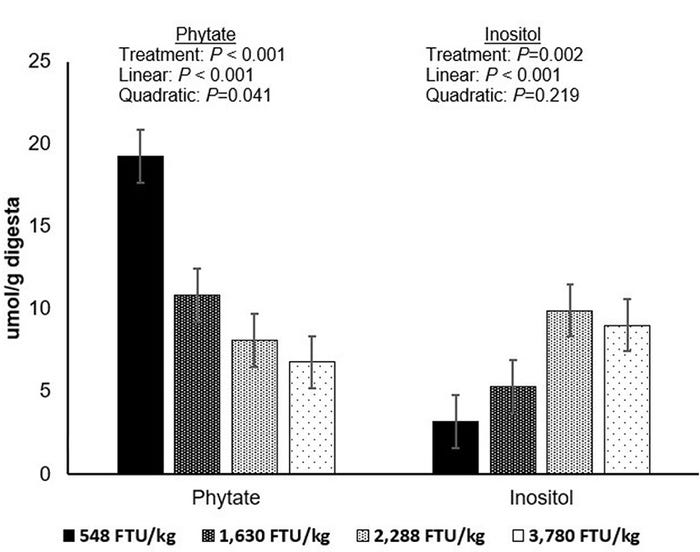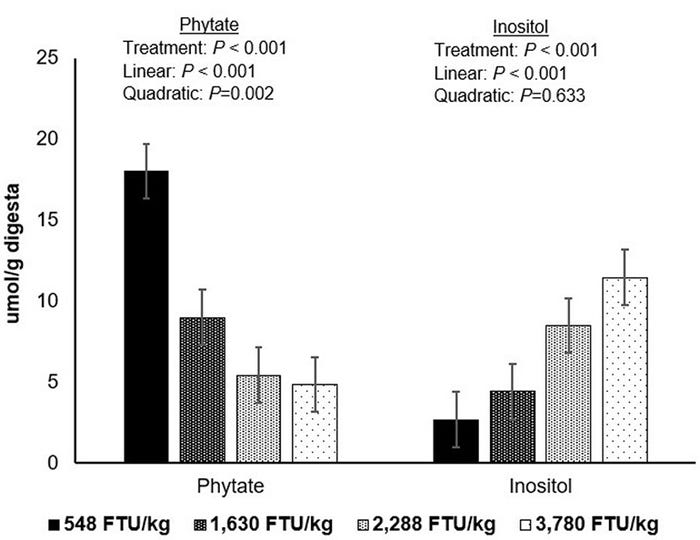Super-dosing phytase reduces the amount of phosphorus bound to phytate, and at the same time, increases the release of inositol in a more or less dose-dependent manner.
August 15, 2019

By Leigh Ruckman, Iowa State University Graduate Student, and John Patience, Iowa State University Professor
Phosphorus is an essential mineral in pig diets that is required for body maintenance and growth, as well as crucial physiological processes. This mineral is naturally abundant in most grains that are fed to pigs. However, the dominant storage form of phosphorus in plants is phytate which cannot be digested by pigs.
Phytate is made up of six molecules of phosphorus bound to a unique chemical on the body called myo-inositol. Non-ruminant animals do not produce enough of the enzyme phytase to free the bound phosphorus. Therefore, phosphorus must be either supplemented directly in the diet, which is expensive, or the enzyme phytase must be added to the diet, which is considerably less expensive. The use of phytase also provides environmental benefits as well.
Phytate does more than bind phosphorus, however. It also binds other important minerals such as calcium and zinc. Phytate may also impair digestion by the pig of amino acids and energy. Phytase is typically added at 250 to 750 FTU (phytase units) per kilogram to improve the availability of phosphorus. Some release of other minerals, energy and amino acids may occur at the same time.
In the past decade or so, super-dosing phytase has become a common practice, at least in nursery diets and sometimes in grow-finish diets. Super-dosing is defined as including phytase at doses greater than what is needed to satisfy the pig’s phosphorus requirement. Super-dosing phytase has been shown to improve pig growth and feed efficiency, especially in nursery-aged pigs, indicating that phytase could increase the digestibility of energy and amino acids or availability of other minerals. However, previous research at Iowa State University shows that the benefit of super-dosed phytase was the same, whether or not the diet was deficient in energy and amino acids. These results suggest there was more to the story than simply nutrient up-lift. There must be more going on.
The answer could be in the release of inositol from phytate. Previous poultry research supports this view. However, the mode of action of inositol in nutrition is largely unknown, but it is a part of physiological processes such as cell signaling, membrane structure and insulin release.
Nonetheless, there are other data suggesting that simply feeding inositol to the pig provides no benefit. So, the story of phytase remains incomplete; if we are going to use it to maximum performance and financial benefit, we must learn more about its mode of action, especially when super-dosed.
A study was done at Iowa State University to determine whether super-dosing phytase in grow-finish diets would release inositol in a dose dependent manner, and to quantify that release1. Pigs were surgically fitted with a T-cannula at the end of the small intestine; the cannula allows digesta to be collected from the intestinal tract prior to it entering the cecum and large intestine where microbial activity could break down and utilize inositol for their own purposes and not for the benefit of the pig.

Three 16-day experiments were conducted at different body weights: 40 kilograms, 60 kilograms and 80 kilograms. There were four dietary treatments containing phytase at 548 (control), 1,630, 2,288 and 3,780 FTU per kilogram. The control diet was formulated to fully meet the pigs’ requirement for phosphorus and other nutrients. Ileal digesta was collected and analyzed for phytate and free inositol.

In all three experiments, super-dosing phytase reduced phytate concentration, and increased inositol concentrations, in a dose-dependent, curvilinear fashion (P < 0.05). Compared to the control diet, super-dosing phytase at the highest level (3,780 FTU per kilogram) reduced phytate concentration by 71%, 73% and 71%, and increased free inositol by 183%, 336% and 292% in the three experiments, respectively.

In conclusion, super-dosing phytase reduces the amount of phosphorus bound to phytate, and at the same time, increases the release of inositol in a more or less dose-dependent manner. It remains to be seen if this helps to explain the full benefit of super-dosing phytase, beyond simply increasing the availability of minerals and amino acids, as well as energy, in the diet.
1Holloway, C.L. 2016. Impact of super-dosing phytase on growth performance, energy and nutrient utilization and phytate breakdown. MS Thesis. Iowa State Univ., Ames.
Sources: Leigh Ruckman and John Patience, who are solely responsible for the information provided, and wholly own the information. Informa Business Media and all its subsidiaries are not responsible for any of the content contained in this information asset.
You May Also Like


